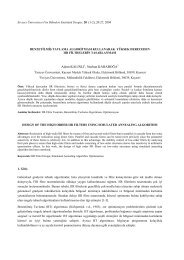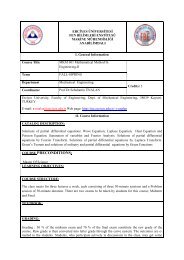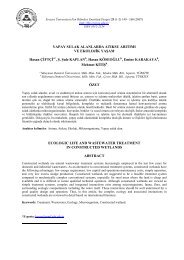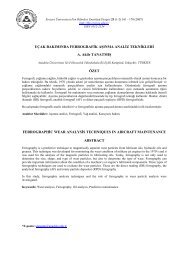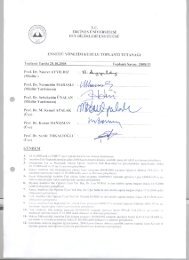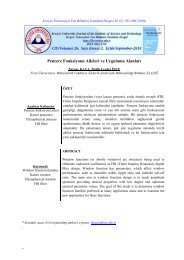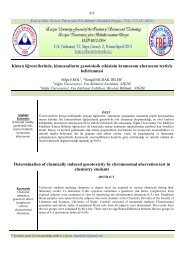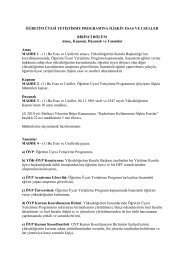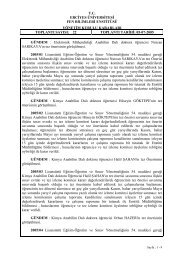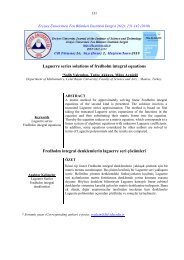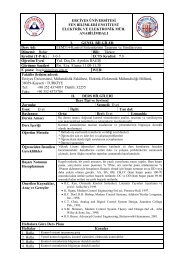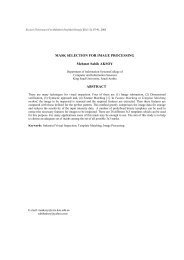ELECTRON TRANSPORT AND MOBILITY CALCULATION IN A ...
ELECTRON TRANSPORT AND MOBILITY CALCULATION IN A ...
ELECTRON TRANSPORT AND MOBILITY CALCULATION IN A ...
You also want an ePaper? Increase the reach of your titles
YUMPU automatically turns print PDFs into web optimized ePapers that Google loves.
Erciyes Üniversitesi Fen Bilimleri Enstitüsü Dergisi 21 (1-2), 13-23, 2005<strong>ELECTRON</strong> <strong>TRANSPORT</strong> <strong>AND</strong> <strong>MOBILITY</strong> <strong>CALCULATION</strong> <strong>IN</strong> AALGAAS/GAAS 2DEG BY MONTE CARLO METHODZeki YARAR, Berrin ÖZDEMIR, Metin ÖZDEMIR*Department of Physics, Çukurova University, 01330 Adana, TurkeyABSTRACTWe study the transport properties of quasi-two dimensional electrons confined to a modulation doped AlGaAs/GaAsheterostructure. Schrödinger and Poisson equations are solved self consistently to obtain the potential profile formedat the heterojunction. In addition, empty or occupied quantized energy levels, charge carrier concentrations in eachoccupied level, wave functions corresponding to each level are also calculated. No adjustable parameters are used, itis sufficient to provide only the material parameters and doping profiles across the junction. Once the wavefunctions are obtained, electron scattering rates based on Born approximation are calculated using a combination ofanalytical and numerical methods. The scattering rates calculated are those due to remote ionized impurities,acoustic phonons and polar optic phonons. Phonons are assumed to be 3-dimensional and interface roughnessscattering and carrier-carrier scatterings are not included. The drift velocities of electrons along the heterojunctionplane are obtained as a function of applied electric field at various temperatures and material parameters usingensemble Monte Carlo method. Mobility calculations are carried out as a function of temperature and as a functionof the applied field to the electrons. The subband and valley populations of electrons are also obtained. It is foundthat the two dimensional nature of confined electrons remains only at low temperatures and at low applied fields, athigher fields the electrons are quickly transferred to higher levels and eventually they become three dimensionalelectrons. High mobility values are obtained at the temperatures and field values where the two dimensional natureof the system is preserved.Key words: 2DEG, mobility, modulation doping, AlGaAs/GaAs, self consistentALGAAS/GAAS YAPISI İÇİN 2BEG’N<strong>IN</strong> MONTE CARLO YÖNTEMİ İLEELEKTRON İLETİMİ VE MOBİLİTE HESAPLARIÖZETModülasyon katkılı AlGaAs/GaAs tipi çokluyapıların arayüzeyinde oluşan iki boyutlu elektron gazının (2BEG)iletim özellikleri çalışıldı. Çoklueklem arayüzeyinde oluşan potansiyel profilini elde edebilmek için Schrödinger vePoisson denklemleri sayısal olarak kendi içinde uyumlu olarak çözüldü. Boş veya dolu enerji seviyelerine ek olarakdolu enerji seviyelerinde bulunan elektron yoğunluğu ve her seviyeye karşılık gelen dalga fonksiyonlarıhesaplanmıştır. Çözümde hiç bir uyum parametresi kullanılmamış, sadece malzeme parametrelerinin verilmesiyeterli olmuştur. Dalga fonksiyonları elde edildikten sonra iki boyutlu elektronların saçılma oranları Born yaklaşımıtemel alınarak analitik ve sayısal yöntemlerle hesaplanmıştır. Gözönüne alınan saçılma mekanizmaları eklem arayüzeyi dışındaki (uzak) iyonize safsızlıklardan saçılma, akustik ve polar optik fonon saçılmalarıdır. Fononların üçboyutlu olduğu kabul edilmiş, taşıyıcı-taşıyıcı ve pürüzlü arayüzey saçılmaları göz önüne alınmamıştır. Monte Carloyöntemi kullanılarak elektronların çoklueklem düzlemine paralel olarak sürüklenme hızları uygulanan alanın birfonksiyonu olarak değişik sıcaklık ve malzeme parametre değerlerinde bulunmuştur. Sıcaklığın ve elektronlarauygulanan alanın bir fonksiyonu olarak mobilite hesapları yapılmıştır. Ayrıca elektronların kesikli alt bant ve üçboyutlu vadi dolulukları da elde edilmiştir. Elektronların iki boyutlu doğasının sadece düşük sıcaklıklar ve düşükalanlarda sağlanabildiği, yüksek alanlarda elektronların çabucak daha yüksek seviyelere geçerek üç boyutlu (3D)oldukları bulunmuştur. Sistemin iki boyutlu doğasının korunduğu sıcaklık ve alan değerlerinde yüksek mobilitedeğerleri elde edilmiştir.Anahtar Kelimeler: 2BEG, mobilite, modülasyan katkılama, AlGaAs/GaAs, kendi içinde uyumluE-posta: metoz@cu.edu.tr
14Erciyes Üniversitesi Fen Bilimleri Enstitüsü Dergisi 21 (1-2), 13-23, 20051. <strong>IN</strong>TRODUCTIONElectronic properties of systems confined to lower dimensions have been studied immensely for a long time[1-3].The transport properties of two-dimensional systems have widely been studied to build high performance electronicdevices such as MODFETs (Modulation Doped Field Effect Transistors) which is also called HEMTs (HighElectron Mobility Transistors) and optical devices such as lasers and quantum well photo detectors[4]. A typicalexample is high electron mobility transistors which take advantage of the separation between the electrons and theirdonor impurities. The conductive channel consists of a single heterojunction, thus the electronic states are quantized,and the electron motion is quasi two-dimensional. This two dimensional electron gas (2DEG) exhibits goodtransport properties and high electron velocities. A typical method to use in order to understand device physics andto explore possible future device architectures is the Monte Carlo technique[3,5,6]. In this paper we provide anunderstanding of two dimensional electron transport along the hetero interface formed at a AlGaAs/GaAs junction atvarious temperatures. The velocity of carriers, the occupancy of quasi two dimensional subband energy levels at theheterojunction and the occupancy of three dimensional valleys in GaAs are provided. Mobility of carriers asfunction of temperature and applied field are also presented. The paper is organized as follows: In section II a briefaccount of the self consistent method used in this study and scattering rates that are used in Monte Carlo calculationsare presented. Section III presents the results and a discussion. Conclusions are provided in Section IV.2. THEORYThe geometry of the sample studied is shown in Figure 1. The z-direction is assumed to be the growth direction,namely it is assumed to be perpendicular to the GaAs/AlGaAs layers. The one-dimensional, one electronSchrödinger equation at the AlGaAs/GaAs heterojunction can be written as[7,8]2d ⎛ 1 d ⎞− h ⎜ ⎟ Ψ(z)+ V ( z)Ψ(z)= EΨ(z)(1)2 dz*m ( z)dz⎝ ⎠where Ψ(z)is the wave function corresponding to quantized levels, E is the energy, V is the one dimensionalpotential at the hetero interface, h is Planck’s constant divided by 2π and m * (z) is the effective mass of the electronswhose variation along the direction perpendicular to the interface is taken in to account. The one dimensionalPoisson equation at the heterojunction can be written asddz( N ( z)− n(z)− N ( z))⎛ d ⎞ − q⎜ εDAs ( z)⎟ φ(z)=(2)⎝ dz ⎠ε0where ε s is the dielectric constant of the material, ε 0 is the permittivity of free space, φ is the electrostatic potential,N D is the ionized donor concentration, n(z) is the total two dimensional electron density and N A is the density ofionized acceptors at the junction. The potential V(z) is related to the electrostatic potential φ(z) asV ( z)= −eφ ( z)+ ∆E( z)(3)cwhere ∆E c represents the conduction band discontinuity at AlGaAs/GaAs hetero interface. The wave functionΨ (z) in equation (1) and the electron density n(z) in equation (2) are related bym*m= ∑∞ 1n( z)Ψk( z)Ψk( z)nkwhere nk =dE2 ∫ ( E−EF) / kTπh1 + ek=1*Ek(4)where E k is the eigen energy and E F is the Fermi energy level.
Erciyes Üniversitesi Fen Bilimleri Enstitüsü Dergisi 21 (1-2), 13-23, 2005 15Equations (1) and (2) are discretized using finite difference approximations for derivatives[8,9,10] and an iterativemethod is used to solve them self consistently. A first guess for V(z) is used to find eigen functions Ψi(z)andenergy eigen values E i from (1) and (2). Then electron density n(z) and the electron density n i in each level are foundfrom equations (4). Next, a new electrostatic potential φ(z) is determined from the solution of Poisson equation (2)using the computed value of n(z) and the doping profiles. Finally a new potential V(z) is obtained from equation (3).This procedure is repeated until the potential does not vary beyond a predetermined error tolerance. From thesesolutions one obtains quantized energy levels (empty or occupied), charge carrier concentrations in each occupiedlevel, wave functions corresponding to each level and the potential profile formed at the interface[8,9]. A typicalheterostructure and the corresponding potential profile together with the wave functions for the ground and firstexcited states are shown in Figures 1 and 2, respectively.The calculation of scattering rates in a quasi-two-dimensional electron gas can be made if the following matrixelements are properly calculated for the subband wave functions. The scattering rate of electrons in the Bornapproximation is given by[11]2πΩ2W ( k)= ′ ′∫∫∫k H k δ(Ek ′ − Ekm hω0) dqzq||dq||dθh3(2π)(5)where k is the electron wave vector before scattering, k′ is the electron wave vector after scattering, q ||is the2 2 2 2 2 2phonon wave vector on the heterojunction plane such that q||= q x+ qyand q = q||+ q z, q z is the componentof phonon wave vector in the z-direction and H′ is the perturbation Hamiltonian corresponding to the scatteringmechanism under consideration. The delta function in equation (5) represents energy conservation and the term ħω 0is the energy of phonons considered. It is now necessary to compute the squared scattering matrix elementsappearing in equation (5). For the acoustic phonon scattering due to deformation potential it is given by[11]22 ΖdkBTL2k′ H ′ k = Gm,n( qz) δ ( k′||− k||m q||)(6)cLΩwhere the proportionality constant Ζdis termed the acoustic deformation potential, T L is the lattice temperature, k Bis Boltzmann’s constant, c L is the materials elastic constant, ω 0 is the angular frequency of optical phonons assumedto be constant and Ω is the volume of the crystal under consideration, and k||and k′||are respectively, the in planecomponent of electron wave vector before and after the scattering. Acoustic phonon scattering is assumed to beelastic, i.e. the ħω 0 term in equation (5) is neglected since the energy of acoustic phonons is much less thanelectron’s energy. The term G m,n (q z ) in equation (6) represents the matrix element in the restricted direction (zdirection)and is given by∞∫−∞iq zzGm, n ( qz) = Ψn( z)e Ψm( z)dz(7)where the range of integration in z-direction does not necessarily extend to ±∞ since subband wave functionseffectively vanish outside a certain region.Insertion of equation (6) into equation (5) and integration over possible final states, taking into account the energyand momentum conservation, results in the following scattering rates from the m-th subband to the n-th subbandWm→nZ( k)=2d k BTL3h cLm*Φ(m,n)for the acoustic phonons where Φ(m,n) is given by(8)
16Erciyes Üniversitesi Fen Bilimleri Enstitüsü Dergisi 21 (1-2), 13-23, 2005q−qz max∫Φ(m , n)= G ( q dq(9)z max2m, n z )zLongitudinal optic phonon scattering of two dimensional carriers is given by[12]W∞2γπ Gmn( qz)=∫dqz2 4 22−∞qz+ 2qz2 * 2 * 2( 2k− 2m∆ / h ) + ( 2m∆ / h )i(10)where ∆ =E m -E n ±ħω where E i is the energy of i-th subband and the constant pre factor γ is defined as* 22 2m e ωP/( 2π) with P given by P = ( 1/ε∞ −1/ε s )( N 0 + 1/ 2 m1/2). The factor ( N + 1/ 2 1/ 2)γ = 2 h0 mrepresents the phonon density within the crystal. The upper sign represents absorption, which reduces the phononpopulation from (N 0 +1) to N 0 , while the lower sign represents emission of a phonon, which increases the number ofphonons from N 0 to (N 0 +1).Finally for remote impurity scattering rate from k || to k′ || =k || +q || can be written as[13]nW ( k ) =||(2D)*imp m3πhe2 2kdq2tot||∫φnm( q||)0 k 1− ( q / 2k)||||||2(11)tot( 2D)where φnm( q ||) is the total induced potential due to remote impurities including screening effects, nimpis thedensity of remote impurities per unit area and the range of integration extends up to Fermi wave vector (k F ) || [7,13].The integrations in equations (7, 9, 10 and 11) are carried out numerically[10]. Using these calculated scatteringrates, the drift velocity of electrons along the interface (parallel to the interface) under an applied electric field isinvestigated by using ensemble Monte Carlo technique[11]. For electrons whose energy increase under the appliedfield and as a result transfer to three dimensional high energy valleys, three dimensional scattering rates are used.Only the Γ and L valleys of GaAs are considered. The scattering rates considered for the three dimensional electronsare as follows: acoustic, polar and non-polar optical phonon scatterings [14-17]. The selection of scatteringprocesses are carried out as usual [11,17] for a typical Monte Carlo calculation.3. RESULTS <strong>AND</strong> DISCUSSIONOur model of modulation-doped GaAs/Al 0.3 Ga 0.7 As structure, its self-consistently calculated potential profile andthe wave functions for the ground and first excited states are shown in Figures 1 and 2, respectively. A potentialdifference of 0.5 V is assumed to be applied to 150 Å thick GaAs cap to compensate for the depletion charge layer.The cap is followed by a 200 Å thick doped AlGaAs layer on which a 100 Å un-doped AlGaAs layeris located which is called the spacer. The GaAs base is made as large as possible to obtain convergent results innumerical calculations. The material parameters used in the calculations are as given in Table 1.Figure 2 shows the calculated subband wave functions at 4.2 K for the lattice matched GaAs/Al 0.3 Ga 0.7 Asheterostructure with AlGaAs layer donor doping of 1x10 18 cm -3 . The energy levels at this temperature are found tobe 33 and 41 meV with respect to potential well minima, respectively for the ground and first excited states. In orderto see the effects of various scattering mechanisms on the ‘two dimensional electron gas’ transport properties,ensemble Monte Carlo simulations are carried out for various electric field values in the range 0.1 to 6 kV/cmapplied to the carriers parallel to the hetero interface. Intra and inter subband scattering of electrons between the twodimensional ground and first exited states are considered. Electrons whose energy exceeds the maxima of theconduction band energy on the GaAs side in Figure 2 are assumed to be three dimensional and treated as such. Thisassumption can be justified due to the closer spacing of the energy levels at high energies, which forms a quasicontinuum as in the case of bulk material. Only the two valleys of the conduction band, namely Γ and L valleys ofbulk GaAs are considered, the effect of X valley is neglected. Non-parabolicity effects of the bands are consideredexcept for the scattering by polar optical phonons for which the parabolic band model is used.
Erciyes Üniversitesi Fen Bilimleri Enstitüsü Dergisi 21 (1-2), 13-23, 2005 17150 Å GaAs N D = 1x10 18x200 Å GaAlAs N D = 1x10 18z100 Å AlGaAs NID2500 Å GaAs NIDGaAs substrateFigure 1. Structure of the quasi two dimensional channel in the modulation doped GaAs/Al 0.3 Ga 0.7 As heterostructure. The dielectric constants of AlGaAs and GaAs are 13.1 and 12.9, respectively.Table 1. The material parameters used in the calculations. The geometry of the sample is shown in Figure 1. m 0 isthe mass of free electron (9.1x 10 -31 kg).Dielectric constant of GaAs 12.9Dielectric constant of AlGaAs 13.1Deformation potential for acoustic phonons Z d (GaAs) (eV) 7.0Deformation potential for non polar optical phonons D eq 1x10 11(GaAs) (eV/m)Inter valley deformation potential for polar optical phonons 1x10 11D ij (GaAs) (eV)Optical phonon energy, ħω 0 (eV) 0.0354Effective mass, m * m * Γ=0.067 m 0m * L=0.35 m 0Doping concentration, (cm -3 ) N D =1x10 18 , N A =0The trajectory of the electron subjected to two-dimensional scattering mechanisms is followed as a function of timeand the electron is placed in the 3D system after the electron’s energy exceeds the edge of the conduction band. Thescattering mechanisms included in the simulation for the two dimensional (2D) system are acoustic phononscattering[11], polar optical phonon scattering[12], and remote impurity scattering[7,13]. The scattering mechanismsconsidered for the three dimensional electrons are acoustic, polar and non-polar optical phonon scatterings [14-17].Self-consistently calculated electronic states were used in the calculation of the 2D scattering rates.Velocity-time characteristics for GaAs/Al 0.3 Ga 0.7 As modulation doped heterostructures for different applied electricfields are shown in Figure 3. It can easily be seen from the figure that velocities exhibit large transient overshoots athigh fields before the steady state values are reached. This is due to the disparity of the momentum and energyrelaxation times as functions of electron energy. Transient overshoot is typically observed when the electric fieldapplied is so high that electrons can reach the high-energy region, where the momentum relaxation time is smallerthan the energy relaxation time. Later energy relaxation becomes effective so that the distribution function spreadsand the drift velocity decreases.We also note that the velocity overshoot in GaAs/Al 0.3 Ga 0.7 As is observed when the electric field is higher thanabout 0.5 kV/cm as seen in Figure 3. At lower fields it takes a long time to reach the steady state velocity where thevelocity makes a couple of oscillations before reaching the steady state value. Further notice that there is a transitionregion through which the characteristic behavior of the velocity-time changes especially for applied field valuesabove 3 kV/cm. This is apparent for example for an applied field of 4 kV/cm in Figure 3 where there are two peaks
18Erciyes Üniversitesi Fen Bilimleri Enstitüsü Dergisi 21 (1-2), 13-23, 2005in velocity. The first peak in velocity is due to the two dimensional electrons and the second peak is due to electronsmainly in the Γ valley. The second peak begins to decrease from the moment the L valley begins to be populated.V(eV)-0.2 0.0 0.2 0.4 0.6Wave Function (Arb. Units)Let us now consider Figure 3 in some more detail. For all applied field values in that figure, there are two regionsfor the rate of velocity increase as a function of time until the maximum velocity value is attained. For example,consider the velocity curve that corresponds to an applied field of 0.5 kV/cm. The velocity increases at a specific50.0E+0 1.0E+3 2.0E+3Position ( Å )Figure 2. Potential profile (thick line) and wave functions corresponding to ground (thin line) and firstexcited (dashed line) states.6 kV/cm45 kV/cm4 kV/cm3 kV/cmVelocity ( 10 7 cm / s )322 kV/cm1 kV/cm10.5 kV/cm0.4 KV/cm0.3 kV/cm0.2 kV/cm0.1 kV/cm00 2 4 6Time (ps)Figure 3. Average velocity of electrons as a function of time at various applied fields parallel to the heterointerface. Note that overshoot effects become apparent at fields above about 0.5 kV/cm. At lowerfields, it takes a long time compared to higher fields to reach the steady state velocity. The rate ofvelocity increase has two regimes, the first one is due to electrons in the ground and first subbands,and the second part is mainly due to electrons in the Γ and L valleys.
Erciyes Üniversitesi Fen Bilimleri Enstitüsü Dergisi 21 (1-2), 13-23, 2005 19rate up to about 2 ps, and then it increases at a different rate after that time until it reaches its maximum value. Theformer rate is mainly due to electrons in the two dimensional system and the latter is mainly due to electrons that aretransferred from two dimensions to the three dimensional Γ valley. This mentioned behavior exists in all curvesdepicted in Figure 3. Consider the velocity curve for an applied field of 2 kV/cm in Figure 3. The same curve isshown in Figure 4 together with the electron occupancies of two dimensional energy levels and 3D Γ and L valleysof GaAs. As can be seen in Figure 4, the velocity increases until all electrons are transferred from the ground andfirst subbands to the 3D Γ valley at a certain rate (up to 0.5 ps), and at a different rate after all electrons aretransferred to the Γ valley. When the velocity has reached its maximum value in Figures 3 or 4 for an applied fieldF=2 kV/cm, all electrons were already in Γ valley and hence the velocity overshoot observed for the present value ofapplied field is solely due to electrons in the Γ valley. The L valley is almost empty at this field value. But as theapplied field value increases, the two dimensional electrons reach high velocity values in a short time and aretransferred from two dimensional system to 3D very quickly. When they become 3D in Γ valley, depending on thefield value, either the velocity decreases and reaches the steady state value as for example in the case of an applied51-st subband1004 Band80Velocity (10 7 cm/s)322 kV/cmvelocity4 kV/cm5 kV/cm6040% Population1L Band2002-nd subband0 2 4 6Time (ps)Figure 4. Sub band and Γand L valley occupancies as a function of time at 4.2 K at applied field valuesof 2 (short dashed lines) 4 (dashed dotted lines) and 5 kV/cm (solid lines). The averagevelocity of electrons is also depicted to show the correspondence between level and valleyoccupancies and electron velocity. Notice the development of a second peak in velocity as theapplied field increases.0
20Erciyes Üniversitesi Fen Bilimleri Enstitüsü Dergisi 21 (1-2), 13-23, 2005Velocity (10 7 cm/s )0.0 1.0 2.0 3.0 4.04.2 K150 K300 K0.0 10.0 20.0 30.0 40.0 50.0Electric Field (kV/cm)Figure 5. Average electron velocity-electric field curves at different temperatures. The average velocitydecreases as the applied field increases, a phenomenon known as negative differentialresistance.1E+5Mobility ( cm 2 /V.s)1E+41E+31 10 100 1000Temperature ( K o )Figure 6. Mobility of electrons as a function of temperature at an applied electric field of 0.5 kV/cm inthe absence of remote impurity scattering. High mobility values are attainable only at lowtemperatures and low applied field values. This is precisely when the system has strictly a twodimensional character.field of 3 kV/cm in Figure 3, or it continues to increase but at a lower rate and then decrease again as in the case ofan applied field of 5 kV/cm in Figure 3. There is a transition region of applied field for these two differentbehaviors. Consider the velocity curve in Figure 3 for F=4 kV/cm where two peaks appear in velocity timecharacteristic (or dashed dotted line in Figure 4). The two dimensional electrons linearly accelerate with time andreach a maximum velocity. After the Γ valley begins populating, the velocity decreases for a while and begins toincrease again and forms the second peak in velocity up until the L valley begin to populate. After this point the
Erciyes Üniversitesi Fen Bilimleri Enstitüsü Dergisi 21 (1-2), 13-23, 2005 21velocity starts to decrease again and after a while reaches a steady state value. At higher fields, for example at anapplied field of 5 kV/cm shown in Figure 3 (or solid line in Figure 4) electrons accelerate linearly with time until thetwo dimensional levels are completely emptied. After the electrons fully become three dimensional by transferringto the Γ valley, their velocity continues to increase linearly but at a lower rate compared to the two dimensionalcase. Although the electrons spend less time in the Γ valley compared to the case of 4 kV/cm applied field, there isstill no decrease in velocity when the electrons are in the Γ valley in this case since the applied field is high enough1E+6·Mobility ( cm 2 /Vs)·1E+51E+4NO RIRI1E+30.10 1.00Electric Field ( kV/cm )Figure 7. The mobility of electrons as a function of applied field at 4.2 K in the absence (diamonds) andin the presence (triangles) of remote impurity scattering. Remote impurity scattering can reducethe mobility as seen here by a factor of ten. The mobility decreases as the applied field and/or thetemperature increases.to cause the electrons continue to speed up on the average. The decrease in velocity at high F values always occursafter the L valley begins to populate as can be seen in Figure 4. The velocity begin to decrease immediately after theL valley starts getting populated for all cases considered because the effective mass of the electron increases in the Lvalley. The variation of electron velocity as a function of applied electric field is shown in Figure 5 at varioustemperatures. For each temperature the velocity increases almost linearly at low fields, reaches a maximum valueand then starts to decrease, a property known as negative differential resistance. The maximum speed attained at agiven field value decreases as the temperature increases. This can be attributed to the increase in scattering rates dueto optical phonons. A small shift of the field to higher values at which the maximum speed is achieved astemperature increases can also be seen in Figure 5. This shift is due to again the increase in optical phononscattering rates as temperature increases since higher field values are required to attain the maximum speed. Exceptfor low field values, the velocity-field characteristics shown in Figure 5 are all due to electrons transferred to the Γand L valleys of GaAs since the two dimensional nature of the system considered is maintained only at very lowtemperatures and low applied field values. When steady state is reached particles are distributed in Γ and L valleysonly and the ground and first subbands are emptied completely as can be seen in Figure 4. The occupancy of groundsubband decreases sharply shortly after the field is applied and electrons are transferred to higher levels and valleys.Therefore the system is in fact two dimensional for a short duration at moderate field values and it completelybecomes a three dimensional system after a while. Therefore a truly two dimensional system is achievable only atlow applied field values (< 0.5 kV/cm) and low temperatures (< 100 K) such that an insignificant amount ofelectrons are transferred to the Γ and L valleys.
22Erciyes Üniversitesi Fen Bilimleri Enstitüsü Dergisi 21 (1-2), 13-23, 2005Mobility calculations of the system under consideration is carried out at various temperature and applied field valuesalso. The variation of electron mobility as a function of temperature is shown in Figure 6 where remote impurityscattering is not taken into account. The applied field is 0.5 kV/cm so that the system is mainly two dimensional fortemperatures up to about 100 K. Beyond this temperature most of the carriers are transferred to the Γ valley andhence the system becomes three dimensional. The mobility is as high as 4x10 4 cm 2 /V·s at low temperatures but itapproaches the bulk value at room temperature since the system becomes completely three dimensional at thesetemperature values. The variation of mobility as a function of applied field at 4.2 K is shown in Figure 7 in theabsence and in the presence of remote impurity scattering. High mobility values are attainable only at lowtemperatures and low applied fields. As the temperature or applied field increases the mobility decreases andapproaches its room temperature bulk values. To see the effect of remote impurity scattering on mobility, themobility values in the presence of remote impurity scattering for a spacer thickness of 100 Å (see Figure 1) is alsocalculated as shown in Figure 7. Mobility values without remote impurity scattering are almost ten times higher atlow field values. To reduce the effect of remote impurity scattering, the spacer thickness must be increased, but ifthe spacer is too thick then it becomes hard to create a potential well at the junction where the electrons would beheld in two dimensions. Therefore an optimum value of spacer thickness must be chosen where there are enoughnumber of electrons in the two dimensional system and the donor impurities left by the free electrons areconsiderably far away from the junction not to interfere with the motion of two dimensional electrons.4. CONCLUSIONSWe presented a numerical study of the transport properties of a two dimensional electron gas formed at aAlGaAs/GaAs heterojunction under an applied field along the interface plane. The potential profile is obtained bythe numerical self consistent solution of Schrödinger and Poisson equations. At most two subbands are populated attemperatures and material parameters of interest in this study. Velocity overshoot effects are clearly observed forfields above 0.5 kV/cm. Further the negative differential resistance phenomena resulting from the inter valleyscattering for GaAs type materials is also visible at all temperatures studied. Subband level and valley electronoccupancies are obtained as functions of transient time at various applied fields and the results are seen to becompatible with average electron velocity variation. The system considered in this study maintains its twodimensional character only at low temperatures and low applied fields. Mobility calculations are also carried out andit is seen that high mobility values are attainable only at low temperatures and low applied field values. To see theeffect of remote impurity scattering, two mobility calculations are carried out for a fixed value of spacer thickness. Itis seen that the mobility can be ten times higher when remote impurity scattering is not in effect. Further work alongthese lines for quantum wells is in progress.ACKNOWLEDGEMENTSThis work is supported in part by Cukurova University Research Fund no: FBE2002D38.REFERENCES1. Ando,T., Fowler, A.B. and Stern, F., Rev. Mod. Phys., 54, 437, 1982.2. Weisbuch, C., and Vinter, B., Quantum Semiconductor Structures, Academic Press, New York, 19913. Jacoboni, C., and Reggiani, L., Rev. Mod. Phys., 55, 645, 1983.4. Stern, F., and Howard, W., Phys. Rev., 163, 816, 1967.5. Dingle, R., Stormer, H.L., Gossard, A.C., Wiegmann, W., Appl. Phys. Lett., 33, 665, 1978.6. Hess, K., Appl. Phys. Lett., 35, 484, 1979.7. Bastard, G., Wave Mechanics Applied to Semiconductor Heterostructures, Les Editions de Physique, France,1988.8. Tan, I-H.,Snider, G.L., Chang, L.D., and Hu, E.L., J. Appl. Phys., 68, 4071, 1990.9. Ozdemir, B., Yarar, Z., and Ozdemir, M., Turk J Phys., 28, 1, 2004.10. Press, W.H., Teukolsky, S.A., Vetterling, W.T and Flannery, B.P., Numerical Recipes: The Art of Scientific11. Computing (2 nd ed.), Cambridge University Press, USA, 1997.12. Tomizawa, K., Numerical Simulation of Submicron Semiconductor Devices, Artech House Inc, Japan, 1993.13. Harrison, P., Quantum Wells Wires and Dots, John Wily&Sons Ltd., England, 2000.
Erciyes Üniversitesi Fen Bilimleri Enstitüsü Dergisi 21 (1-2), 13-23, 2005 2314. Davies, J.H., The Physics of Low-Dimensional Semiconductors, Cambridge, United Kingdom, 1998.15. Lundstrom, M., Fundamentals of Carrier Transport, Cambridge, United Kingdom, 2000.16. Ridley, B.K., Quantum Process in Semiconductors, Clarendon Press, Oxford, 1982.17. Reggiani, L., Hot Electron Transport in Semiconductors in Topics in Applied Physics 58 Ed. by Reggiani, L.,Springer-Verlag, New York, 1985.18. Jacoboni, C., Lugli, P., The Monte Carlo Method for Semiconductor Device Simulation, Springer-Verlag Wien,New York,1989; Moglestue, C., Monte Carlo Simulation of Semiconductor Devices,Cambridge, London, 1993.



